大型湖库营养盐分布特征与转化规律
2012-12
浙江大学出版社
沈珍瑶 著
183
《大型湖库营养盐分布特征与转化规律(英文版)》主要从污染特征、作用机理、数值模拟、风险评价4个方面论述了大型湖库水体中营养盐分布特征与转化规律。全书通过对了湖库中营养盐的存在概况进行分析,阐述了大型湖库中营养盐的分布特征,研究了水动力条件、生物因素和水化学条件对大型湖库中营养盐的转化规律及作用机理,开展富营养化控制的数学模拟,并对营养盐的生态风险进行了评价。与同类书比较分析,《大型湖库营养盐分布特征与转化规律(英文版)》具有特色性和针对性。特色性:主要的特色是根据大型湖泊的独特特征,阐述营养盐的分布特征和转化规律。针对性:主要针对大型湖泊富营养化的特点,有针对性地揭示营养盐对大型湖泊的生态风险。案例的关注度:选择三峡库区开展工作,成果会引起广泛的关注。
沈珍瑶
1967年生,博士、教授、博士生导师;环境影响评价注册工程师、教育部新世纪优秀人才、国家杰出青年科学基金获得者。现任北京师范大学环境学院副院长、分党委书记。长期从事流域水污染控制、非点源污染控制、流域水环境管理、环境影响评价等方面的研究工作。曾主持或作为主要研究人员参加60余项科研项目,包括国家重点基础研究发展计划(973计划)课题、科技部社会公益研究专项资金项目、国家自然科学基金重点项目、国家自然科学基金项目、核工业科学基金项目等。截止到2010年,共发表学术论文180余篇,其中为SCI收录50余篇,出版专著及教材8部,申请发明专利13项(6项已授权),研究成果中有1项获国家科技进步二等奖,6项获省部级科学技术奖。
基本信息
姓名:沈珍瑶
出生年月:1967年1月
职称职位:教授,博士生导师
教育履历
1984.09-1988.07 中国地质大学水文系,大学本科
1988.09-1991.06 中国地质大学水文系,硕士研究生
1995.09-1998.12 清华大学环境科学与工程系,博士研究生
工作履历
1991.06-1993.10 中国辐射防护研究院 实习研究员
1993.11-1996.07 中国辐射防护研究院 助理研究员
1996.08-1999.12 中国辐射防护研究院 副研究员
2000.01-2001.12 北京师范大学环境科学与工程博士后流动站 博士后研究人员
2002.01-2002.06 北京师范大学环境科学研究所 副教授
2002.07-2003.06 北京师范大学环境科学研究所 教授
2003.07-2003.10 北京师范大学环境科学研究所 教授 副所长
2003.10-2004.11 北京师范大学环境学院 教授 副院长
2004.11-2008.04 北京师范大学环境学院 教授 博导 副院长
2008.04-目前北京师范大学环境学院 教授 博导 分党委书记 副院长
2009.10-2010.01 美国UCLA 高级访问学者
研究方向
流域水污染控制
非点源污染控制
流域水环境管理
环境影响评价
社会职务
中国环境科学学会水环境分会 副理事长
美国化学学会会员
International Journal of Environmental Science and Technology
Associate Editor
《应用基础与工程科学学报》编委
《辐射防护通讯》编委
《环境科学与技术》理事
环境影响评价注册工程师
国家司法鉴定人
获奖
1 Distribution and Transformation of Nutrients in Large-Scale Lakes and Reservoirs 1.1 Introduction 1 2 Water Quality and Eutrophication 1.3 Organization of the Book References2 Eutrophication and Distribution of Nitrogen and Phosphorus 2.1 Overview 2.2 Eutrophication 2.3 Distribution of Nitrogen 2.3.1 Water and Sediment Characteristics of Sample Sites 2.3.2 Distribution of Nitrogen 2.4 Distribution of Nitrogen 2.4.1 Distribution of Phosphorus 2.4.2 Speciation Analysis of Phosphorus References3 Hydrodynamic Effects 3.1 Overview 3.2 Hydrodynamics Processes 3.2.1 Parameters of Turbulence-Simulation Device 3.2.2 Vertical Distribution of Sediment Concentration Under Different Hydrodynamic Conditions 3.2.3 Vertical Distribution of Sediment Particle Size Under Different Hydrodynamic Conditions 3.3 Transformation of Nitrogen 3.3.1 Ammonia Adsorption in Sediments 3.3.2 Ammonia Adsorption with Different Particle Sizes and Organic Matter Contents in the SPs 3.4 Transformation of Phosphorus References4 Biological Effects 4.1 Overview 4.2 Biological Zones 4.2.1 Sampling Locations and Properties 4.2.2 Culturable Bacteria Number on Different Nutrient Level Mediums 4.2.3 Microbial Community Activity 4.2.4 Abundance of Functional Bacteria in Aquatic Environments. 4.3 Transformation of Nitrogen 4.3.1 AOB Strain and Preparation of Inocula 4.3.2 Sample Preparation 4.3.3 Analysis and Enumeration 4.3.4 Ammonia Nitritation 4.3.5 Influence of Suspended Particle Concentration on Nitritation 4.3.6 Influence of Particle Size and Organic Matter Content on Ammonia Oxidation 4.4 Transformation of Phosphorus 4.4.1 Samples Characteristics 4.4.2 The Phosphorus Release Ability of PSB 4.4.3 Release of Phosphorus from Sediment Using PSB at Different Temperatures 4.4.4 The Effect of DO on Phosphorus Release from Sediment Using PSB References5 Chemical Effects 5.1 Overview 5.2 Sediment Components 5.2.1 Sampling Locations and Properties 5.2.2 Sediments Characteristics 5.2.3 Adsorption Capacity of Different Sediments for Phospate 5.2.4 Effect of Sediment Compositions 5.3 pH 5.3.1 The Effect ofpH on Phosphate Release from Sediments 5.3.2 The Effect of pH on Phosphate Adsorption on Sediments 5.4 Temperature 5.5 Ionic Strength References6 Mathematical Modefing and Numerical Simulation 6.1 Overview 6.2 Mathematical Models and Numerical Simulation 6.2.1 Model Description 6.2.2 Model Results Evaluation 6.3 A Macro-Scale One-Dimensional Integrated Model for the Three Gorges Reservoir Area 6.3.1 Data Acquisition and Preprocessing 6.3.2 Model Configuration 6.3.3 Parameters Estimation 6.3.4 Model Calibration 6.3.5 Model Validation 6.4 Three-Dimensional Eutrophication Modeling at the Daning River Confluence at Mouth of the Three Gorges Reservoir Area 6.4.1 Data Acquisition and Preprocessing 6.4.2 Model Configuration 6.4.3 Parameter Estimation 6.4.4 Model Calibration 6.4.5 Model Validatio References7 Eutrophication Risk Assessment 7.1 Overview 7.2 Relationship Between Culturable Becteria and Eutropication in the Waterbody 7.2.1 Eutropltication Level 7.2.2 Culturable Bacteria and Total Bacteria in the Waterbody 7.3 Relationship Between Microbial Community and Eutrophication in the Waterbody 7.4 Abundance of Functional Bacteria in Aquatic Environments 7.5 Eutrophication Risk Assessment and Hydraulic Control in Large Reservoirs 7.5.1 Sensitivity Evaluation for Eutrophication Risk in Large Reservoirs 7.5.2 Hydraulic Control Technology for Prevention of Eutrophication in Large Reservoirs ReferencesIndex
《大型湖库营养盐分布特征与转化规律:三峡水库(英文版)》主要从污染特征、作用机理、数值模拟、风险评价4个方面论述了大型湖库水体中营养盐分布特征与转化规律。全书通过对了湖库中营养盐的存在概况进行分析,阐述了大型湖库中营养盐的分布特征,研究了水动力条件、生物因素和水化学条件对大型湖库中营养盐的转化规律及作用机理,开展富营养化控制的数学模拟,并对营养盐的生态风险进行了评价。与同类书比较分析,《大型湖库营养盐分布特征与转化规律:三峡水库(英文版)》具有特色性和针对性。特色性:主要的特色是根据大型湖泊的独特特征,阐述营养盐的分布特征和转化规律。针对性:主要针对大型湖泊富营养化的特点,有针对性地揭示营养盐对大型湖泊的生态风险。案例的关注度:选择三峡库区开展工作,成果会引起广泛的关注。
